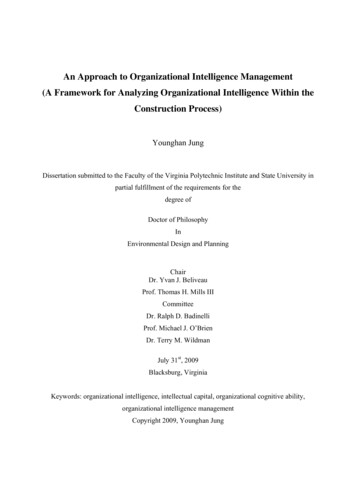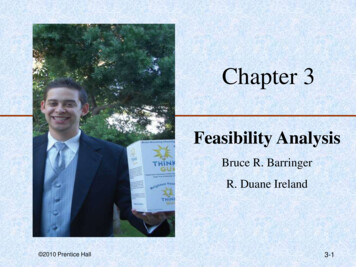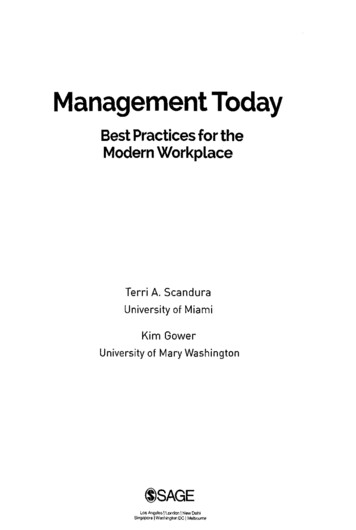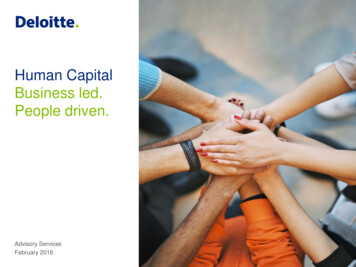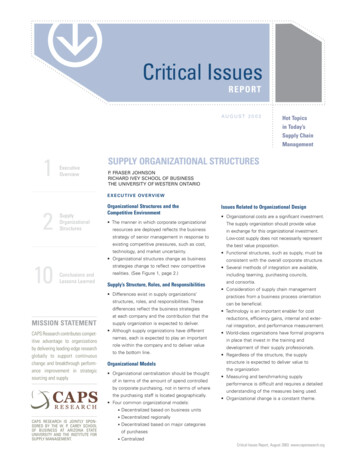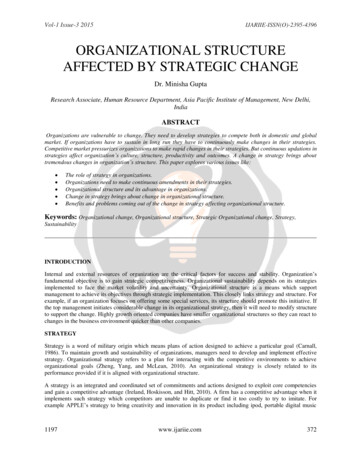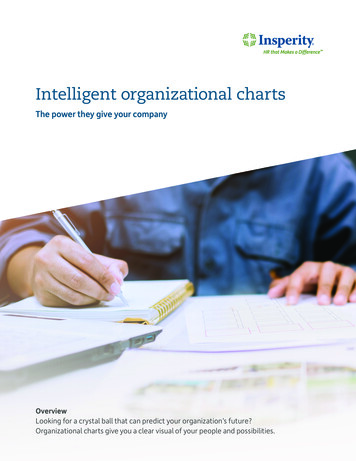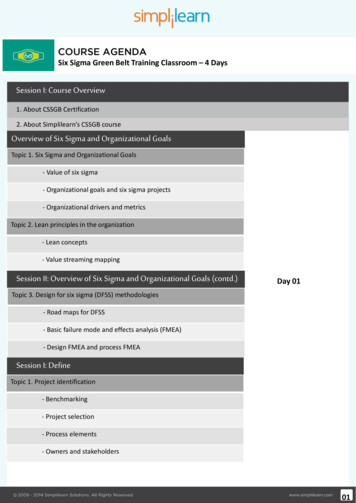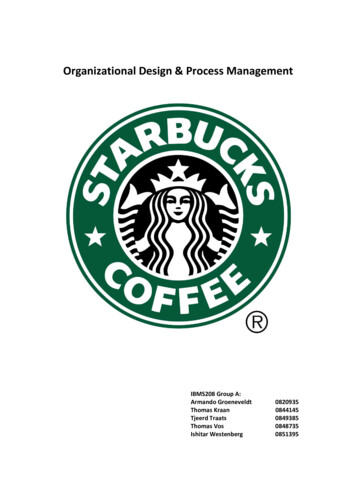
Transcription
Organizational Design & Process ManagementIBMS208 Group A:Armando GroeneveldtThomas KraanTjeerd TraatsThomas VosIshitar Westenberg08209350844145084938508487350851395
Table of ContentsIntroduction . 21. Company Profile . 32. Ethical Problem-Solving and Decision Making . 42.1 Organizational Decision Making Process . 42.2 Main Ethical Issues . 52.2.1 Critics’ Point of View . 52.2.2 Starbucks’s Point of View . 63. Organisational Structure and Organisational Culture . 94. Process Management: Business Process Mapping. 11Conclusion. 13Appendix . 14Bibliography . 171Organizational Design and Process Management: Starbucks
IntroductionIn this document you will find a portfolio based on the analysis of Starbucks using the theoreticalmodules. We have chosen to build a portfolio about Starbucks because there are a lot of opinionsabout the company. Some people credit their mission and the view of a fair world and sustainablefocus. But others dislike the way they use the system to gain an advantage over tax laws andcompetitors. In this document we will elaborate on the organizational design and processmanagement within the company discussing the ethical problem-solving and decision making,organizational structure and culture and the way processes are managed.2Organizational Design and Process Management: Starbucks
1. Company ProfileStarbucks was first opened in 1971 in Seattle’s historic Pike Place Market. The name Starbucks isinspired by the first mate in the novel Moby Dick which gives it a sort of romance of the high seasand tradition of the early coffee traders. Its logo is a twin-tailed siren from Greek mythology.After leaving the company, Howard Schultz bought the company in 1987 and implemented his visionthat grew since he traveled to Italy and became captivated with Italian coffee bars. His vision was tobring the Italian coffeehouse tradition to the United States and create a place for conversation andsense of community. This is where the Starbucks foundation was set of a company that is activelyparticipating in community programs. Therefore Starbucks’ mission statement is “to inspire andnurture the human spirit-one person, one cup and one neighborhood at a time.”Since then Starbucks has grown to be the biggest premier roaster and retailer of specialty coffee inthe world. With more than 18.000 stores and operating in Argentina, Aruba, Australia, Austria,Bahamas, Bahrain, Belgium, Brazil, Bulgaria, Canada, Chile, China,Costa Rica, Curacao, Cyprus, Czech Republic, Denmark, Egypt, El Salvador, England, Finland, France,Germany, Greece, Guatemala, Hong Kong/Macau, Hungary, Indonesia, Ireland, Japan, Jordan,Kuwait, Lebanon, Malaysia, Mexico, Morocco, New Zealand, Netherlands, Northern Ireland, Oman,Peru, Philippines, Poland, Portugal, Qatar, Romania, Russia, Saudi Arabia, Scotland, Singapore, SouthKorea, Spain, Sweden, Switzerland, Taiwan, Thailand, Turkey, United Arab Emirates, United Statesand Wales.Starbucks went public on June 26, 1992 at a price of 17 per share and closed trading that first day at 21.50 per share. Starbucks was incorporated under the laws of the State of Washington, in Olympia,Washington, on Nov. 4, 1985. Starbucks Corporation's common stock is listed on NASDAQ, under thetrading symbol SBUX.3Organizational Design and Process Management: Starbucks
2. Ethical Problem-Solving and Decision Making2.1 Organizational Decision Making Process‘The corporate headquarters is called the Starbucks Support Center which reflects centralmanagement’s role as an information and support provider, not an autocratic decision maker.‘Howard Schultz, Starbucks founderOrganizational challengesOrganizational challenges will constantly arise in an international business; therefore, Starbuckslearns how to manage integration and responsiveness. This part is very important to understand thedecision making within this company.IntegrationStarbucks divides up its company into different geographic regions. Each geographic region has itsown needs and desires. By dividing the world into different countries or regions Starbucks is able tobreak down the differences and similarities between markets. By breaking down its global marketinto smaller geographic areas, it is capable of being more flexible and responsive to varying needsand wants.ExampleStarbucks normally enters a market by joint venture or acquisition of various national companies inorder to gain a hold on the cultural differences within each new geographic regionResponsivenessAnother organizational challenge is to create worldwide learning through cross-border knowledgemanagement. Starbucks does it mainly through its relationships with customers, suppliers, alliancepartners, and its own employees.1 Starbucks’s relationship with its suppliers is one of the best in thecoffee industry with its focus on insuring not only their continued profitability but also theprofitability of the farmers. Apart from this, Starbucks strives to make every employee a “partner” inits business by offering different stock options. By doing this, the company encourages worldwidelearning.Decision makingLike the quote above mentioned, the board is not deciding by what they think is efficient andeffective. The board has of course the biggest influence on the company itself, but probablycommunication with employees is the biggest value to them. Because Starbucks uses joint ventures,the board works together with shareholders in different types of areas. The shop managers who havecontact with daily Starbucks clients inspire the board. Starbucks understands that decisions can bebased on perceptions of individuals, influenced by upbringing, beliefs, or current state of mind.Therefore the "Ethical Decision Making Framework" is provided. This framework guides decisionmakers in a proper working behaviour.It is divided into six points2:1. Identify the ethical problem.2. List possible solutions (what could you do?) and any obstacles to resolving the problem.1Gulati, R., Huffman, S., & Neilson, G. The Barista Principle - Starbucks and the Rise of Relational Capital. 2008. eBaristaPrinciple.pdf .2Hawks, M., Kembell, B., Kembell, S., Olsen, L., & Perry, L. “Catching the Starbucks Fever”. Academicmind.(October 17,2008). Web. June 22 2013. s-fever.html .4Organizational Design and Process Management: Starbucks
3.4.5.6.Seek input from others, if appropriate.Determine the best approach (what should you do?).If the path isn't clear, ask for guidance.Follow through on your decision.In additions the framework provides the following statements:1. As en employee (decision maker) you are supported by Starbucks in doing the right thing anddoing business with integrity.2. The decision maker is supported, that means he/she can have help if needed.3. The decision maker has responsibility in ensuring Starbucks work environment andprotecting the company’s culture.4. Everyone has a voice. If the decision maker thinks something is going wrong within thecompany, he/she has to say it.2.2 Main Ethical Issues2.2.1 Critics’ Point of ViewThere is an ethical battle between Starbucks and its customers, even though Starbucks is one of themost ethical retailers according to the Ethisphere Institute.3Ethisphere used professors, organizational leaders, attorneys, government officials, and their ownmembers who measure the criteria as "good, smart, business, and profit,” which includes4: Corporate Citizenship & ResponsibilityCorporate GovernanceInnovation that contributes to the Public Well BeingIndustry leadershipExecutive leadership and Tone from the TopLegal, Regulatory and Reputation Track RecordInternal Systems and Ethics/Compliance ProgramHowever, according to a leading consumer magazine is Starbucks one of the most unethical caféchains in Britain.Dan Welch, from the Ethical Consumer magazine, ranked Starbucks as being unethical because of itsstance on workers’ rights and its political activities.Although the firm has the sales practice of selling Fair-trade coffee in the UK, the rest of themultinational has been slower on the uptake. The report states that the Fair-trade Fortnight ispotentially misleading on some café websites. It is not possible to trace the origins of all the coffee,thereby it’s impossible to measure the conditions.A spokesperson defended her company, she said that it is disappointing that the authors areunaware of Starbucks widely published ethical standards which guarantees the wages, rights, and3Farfan, Barbara. “Report Says Starbucks, Target, and The Gap are the Most Ethical, But Anti Gay Rights GroupProtest Retail Support of Gay Rights and Gay Marriage.” About.com. (March 30, 2013). Web. May 19 2013. arriage.htm .4“Starbucks takes heat for tip sharing policy”. Etisphere. (March 13, 2008). Web. May 19 2013. -sharing-policy/ .5Organizational Design and Process Management: Starbucks
conditions for coffee farmers and offering the industry a leading environmental performance of thecoffee production.The authors might not even be aware that they independently verify environmental standards for itsstores by cutting water and energy consumption up to 25%. They are neither aware that theemployees benefit from the success of the business by owning a share of the company. According toseveral surveys, customers rate Starbucks to be the top for ethical behavior above all other coffeechains. Within the last two years is Starbuck named to be the most ethical coffee company inEurope5.Tax avoidanceLately Starbucks has been the recipient of negative feedback concerning their business practice ofminimizing corporate taxes in the UK.In the 14 years that Starbucks has been active in the UK, only 8,6 million was paid in corporatetaxes. Notably, in the last three years, no taxes were paid at all in the UK by Starbucks. In the UK,Starbucks is at present valued at over 25 billion. Over the last 14 years, Starbucks has paid less than1% corporate tax over their 3 billion sales in the UK. By comparison, Costa, Starbucks nearestcompetitor, recorded 377 million in sales in the UK, and paid 31% tax over their profit of 15million. Starbucks recorded sales of 398 million over which they paid no taxes at all.Starbucks was able to cut their income taxes by paying fees to other parts of its global business.These fees included, for example, royalty payments for the use of the brand. By doing this, StarbucksUK was effectively making a loss, and therefor they did not have to pay any income taxes, and theydid not break any laws. In 2011, Starbucks UK made a loss on paper of 33 million, but they told theirinvestors that the business in UK was very profitable. This whole tax avoidance operation resulted ina lot of brand damage for Starbucks UK; people were calling on Twitter to boycott Starbucks for itstax avoidance.2.2.2 Starbucks’s Point of ViewEthical ResponsibilityStarbucks has divided their ethical responsibility into 3 categories:1. Community2. Ethical sourcing3. EnvironmentThe Starbucks Community Service ProgramIn every neighborhood where Starbucks has a store, they try to be involved with the localcommunity. From coffee shops to coffee plantations, Starbucks believes that being involved in thelocal community is a very important thing.Bringing people together, inspiring others and making a difference in the lives of people. That is theresponsibility of being a good neighbor. All with the intention of making a positive change on thecommunity.One good example is the voluntary work program where the goal is to have partners, employees andguests of Starbucks participate in more than 1 million of voluntary work hours till 2015. The Workencourages tackling issues that have a direct influence on the local area. The program started in April2010 and helps organize project such as, after school help for students, improving bicycles lanes andcleaning days in parks in cooperation with local non-profit organizations.5Welch, Dan. “Starbucks bottom of ethical rating despite going fairtrade”. Ethical Consumer. (February 28,2011). Web. May 19 2013. ases/mediareleasecoffeeshops.aspx .6Organizational Design and Process Management: Starbucks
Ethical sourcingEthical sourcing is divided into 4 categories:1. Coffee2. Tea3. Cocoa4. Farmers supportIn 2000 Starbuck started to buy only fair-trade coffee and in 2009 Starbucks bought 18 millionkilograms of fair-trade coffee, making them the largest fair-trade coffee user in the world. Starbucksbelieves they have an economical responsibility which means that transparency of the market is amust. Starbucks’ suppliers must show which payments have been done to secure that the farmersreceive honest pay for their product. The Conserva
Organizational Design and Process Management: Starbucks 3. Seek input from others, if appropriate. 4. Determine the best approach (what should you do?). 5. If the path isn't clear, ask for guidance. 6. Follow through on your decision. In additions the framework provides the following statements: 1. As en employee (decision maker) you are supported by Starbucks in doing the right thing and
